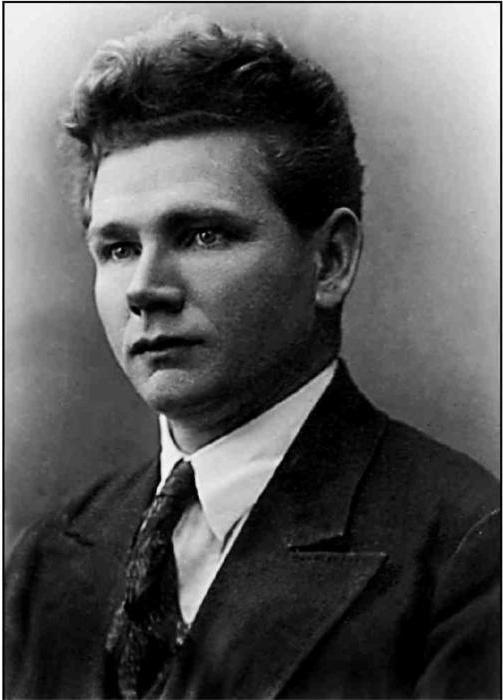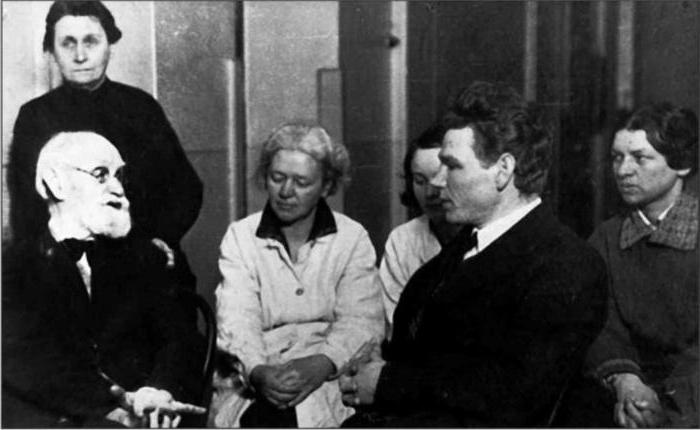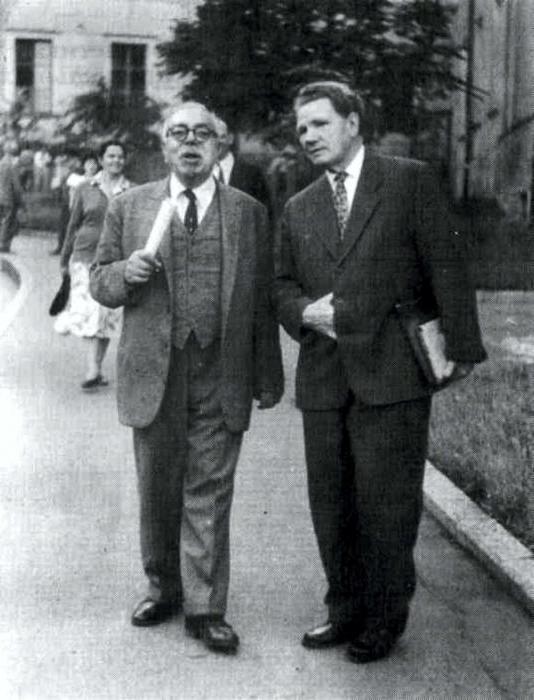The largest physiologist of the 20th century, Petr Kuzmich Anokhin - an academician, the founder of the famous scientific school, the founder of new branches of brain science, which became the forerunner of cybernetics - went the way typical of a Soviet scientist.
Coming from a simple, working family, he became a world-famous physiologist, giving Soviet science priority in many branches of neurophysiology, while being periodically persecuted for his unwillingness to follow an officially approved, ideologically verified course in science.
“I was born in the ravine”
He recalled that father and mother were illiterate and signed with two crosses. This was a common occurrence among the inhabitants of the Ravine - the most proletarian part of Tsaritsyn. Here, in the family of a railway worker, the future academician Anokhin was born. His date of birth is January 27, 1898. Father - Kuzma Vladimirovich - a stern and silent person - was a native of the Don Cossacks. From his mother - Agrafena Prokofievna, originally from the Penza province - he got a lively and sociable character, and the main feature of the boy was curiosity and the pursuit of knowledge.
Before the revolution, he received secondary education - he graduated from a real school (1914) and entered the land surveying and agronomic school in the city of Novocherkassk. Soon he marks for himself an interest in biological science, in knowledge about a person, in particular, about his brain. He begins to take an active interest in scientific literature on this subject, to communicate with natural science teachers who could at least give direction to his educational aspirations.
Civil war veteran
Proletarian descent made it natural for Anokhin to participate in the revolutionary events of 1917, and then in the civil war on the side of the Bolsheviks. During the Cossack uprising in February 1918, Tsaritsyn was threatened, and the young man participated in his defense - he was appointed inspector of the headquarters for the construction of military fortifications. In 1920, he worked actively in communist propaganda - becoming the commissioner for the press in Novocherkassk and the editor-in-chief of the main newspaper of the Don district - Krasny Don.

Serious writing talent is manifested here, which Academician Anokhin always always differed. Peter Kuzmich writes most of the editorials and a ton of newspaper articles. Their lively and figurative language attracts the attention of the People's Commissar of Education A.V. Lunacharsky, who made agitation trips to the front. He wanted to get acquainted with the young author, and a meeting takes place, which had a fateful character for the future scientist. Anokhin told the addict about his desire to study and about his interest in the structure of the human brain, which he retained during all the turbulent events in the country.
Ankylosing spondylitis school
Soon a letter came in containing a request to send Anokhin to study with the famous scientist - Vladimir Mikhailovich Bekhterev, who headed the State Institute of Medical Knowledge in Petrograd. In 1921, Petr Kuzmich enrolled in study at this educational institution. As Anokhin later wrote, Academician Bekhterev did the most important thing for him - he forever tied it to a global, universal scientific problem - to the secret of the human brain, when from the first year he was involved in this research work.
However, student Anokhin soon realizes that he is not attracted to psychiatry - the main area of scientific activity of Ankylosing spondylitis. He sees in it too much unspecific and unsaid, that which is expressed only in verbal form. He is more attracted to the physiology of the brain, the possibility of studying it by setting up experiments with specific results. At that time, Ivan Petrovich Pavlov was the main authority in this area. It was in his laboratory that Anokhin entered in 1922. Academician Pavlov attracts a young scientist to experiments on internal inhibition - the bottleneck of his theory of conditioned reflexes.
Faithful student of Pavlov
To be afraid of the routine in science, not to allow a one-sided look in the work, to avoid blindly following the same conclusions, even if they are part of an apparently harmonious theory, as the great physiologist taught his staff. Therefore, when an article “On Dialectical Materialism and Mental Problems” appeared in 1924, in which some employees of the Pavlovsk laboratory saw an attempt on the main provisions of the doctrine of conditioned reflexes, and the author was Anokhin, the academician himself defended the young scientist.

On the recommendation of Pavlov, Anokhin first becomes a teacher in the Department of Physiology of the Leningrad Zootechnical Institute, and then a professor in the medical faculty of the University of Nizhny Novgorod. On the basis of this faculty, the Gorky Medical Institute was formed, where Anokhin begins his independent scientific and pedagogical activity at the Department of Physiology. The academician, whose biography was for a long time connected with Gorky, left a noticeable mark in the history of the institute and the whole city.
Institute of Experimental Medicine
On the basis of the physiology department of the Gorky Medical Institute, which Anokhin turned into one of the best in the country, a branch of the All-Union Institute of Experimental Medicine was created in 1932, and Anokhin became its director.
In 1935, he was transferred to work at the VNIEM in Moscow as the head of the department of neurophysiology, in which he was actively engaged in experimental studies of higher nervous activity. He establishes active ties with clinical institutions, where he conducts joint research with practicing neurologists and neurosurgeons. The results of these works played an important role during the work of Anokhin on the problems of military injuries of the peripheral nervous system during the Great Patriotic War.
The struggle for the purity of scientific ranks
Many historians of Russian science argue that the removal of Anokhin from the capital to the periphery - in the then Nizhny Novgorod, was carried out on the initiative of Pavlov in order to save him from the inevitable persecution for too independent ideas and actions. So many ideological fighters were shocked by Anokhin’s decision to stop paying party fees in order to voluntarily leave the party. He considered that social work could interfere with his academic activities.
Both Anokhin the student and Anokhin the academician proclaimed their loyalty to the fundamental principles of Pavlovian theory. The scientist argued that those who interpreted the legacy of the great physiologist who brought the ideas expressed by Pavlov as mere assumptions or possible assumptions that did not affect the content and truth of the basic tenets of the theory did the most harm to domestic science.
The defeat of Soviet physiology
Subsequently, he will remember much at the famous Pavlovsk session - a joint meeting of the USSR Academy of Sciences and the USSR Academy of Medical Sciences, which took place in the summer of 1950. Following genetics, Soviet physiology was purged on it. Several leading scientists, respected throughout the scientific world, were brutally persecuted for "deviations from the teachings of Academician Pavlov" and for admiration for the bourgeois idealist trends in physiological science. Pavlov’s closest and most loyal disciples, L. Orbeli, A. Speransky, I. Beritashvili, L. Stern, were ostracized. The views expressed by academician Anokhin were also subjected to harsh criticism. Pyotr Kuzmich, whose biography was connected with the Institute of Physiology at the USSR Academy of Medical Sciences, which he created in 1944, was removed from the leadership and until 1953, until Stalin's death, he worked as a professor at the Department of Physiology of the Medical Institute in Ryazan.
The main scientific contribution
The theory of functional systems is a natural result of the development of Pavlovian theory. This theory is considered by many to be the main scientific achievement of the scientist, his most important contribution to the world science of the human brain. It consists in describing the vital processes of an organism due to the existence in it of special private associations and organizations acting with the help of nervous and humoral (carried out through liquid media) regulations.

Such systems are called self-regulating, because there is constant improvement. The result of the action of such systems is a behavioral act, for the evaluation of which there is inverse afferentation - feedback. This concept is fundamental to the science of methods for obtaining, transmitting, storing and transforming information - cybernetics. The father of this science, Norbert Wiener, highly appreciated the work, the author of which was academician Anokhin. The photo taken during a joint walk between Wiener and Anokhin in Moscow became a symbol of the close relationship between the two sciences.
Biological theories of emotions, theories of wakefulness and sleep, hunger and satiety, mechanisms of internal inhibition - these problems Anokhin actively dealt with in recent years. He combined scientific research with organizational activities in domestic and foreign scientific societies, participating in editorial boards of numerous publications, etc.
PC. Anokhin ended his life March 5, 1974, leaving a good reputation for his human qualities and a huge scientific legacy.